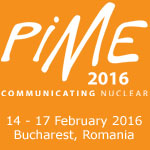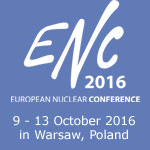
ENS NEWS N° 49: IntroDear Reader, As the new editor-in-chief, I would like to welcome you to the ENS News publication. Over the past ten years, Mr. Mark O’Donovan took great care to bring you a high-quality publication with relevant and interesting content. Now that he has decided to retire, it is up to me to strive and keep the quality of ENS News up to Mark’s standards. The second half of 2015 was marked by numerous events spanning all fields of nuclear energy and nuclear research. Most importantly, all events in the nuclear industry are being focused on the up-coming UNFCCC COP21 climate change conference which will take place in December 2015 in Paris. The conference will bring together 196 nations who will have to hammer out a deal to reduce greenhouse gas emissions and agree to limit the effects of climate change. We all know the target of keeping the temperature increase to 2 degrees C by the end of the century. The nuclear industry has a big stake in climate change mitigation politics, policies and scenarios. Environmentally, nuclear is a low-carbon source of energy and can help avoid CO2 emissions while providing a constant, large-scale power supply. It is indicative that the Intergovernmental Panel on Climate Change, the body which conducts peer-reviews on the science behind climate change, shows only eight out of more than a thousand scenarios which include a nuclear-free way of tackling climate change. Economically, nuclear is very similar to renewable energy sources. Both have a high up-front cost but a very low marginal or operational cost. This means that both nuclear and renewable energy sources cost a lot of money to build but very little to maintain. At the moment, the increased use of renewables has pushed wholesale market prices down (because they cost very little to operate) but consumer prices have gone up (due to subsidies for the up-front costs). This situation is unsustainable for two reasons – utilities are not receiving enough money to cover their operational costs for other electricity generation technologies and consumers are paying every higher prices. One country in Europe to have realised the issues brought in by subsidising renewables is the United Kingdom. After the landslide election victory of the Conservative party, Mr David Cameron has decided to cut subsidies to renewable energy installations. Then, in October, the UK government announced a deal with its Chinese counterparts that 33.5% of the Hinkley Point C nuclear power station will be paid for by Chinese investors. In addition, China will take a large stake in Sizewell B and perhaps even see a Chinese reactor being built at Bradwell. These plans for building four EPR reactors and one Chinese reactor, together with the three Westinghouse AP1000 reactors planned for Moorside and the Hitachi GE ABWR planned for Wylfa, will bring online nine new reactors with a total power output of around 11 GW. The UK’s push for a nuclear new build programme comes in the context of the EU’s pilot project for building an Energy Union. EU Commissioner Maroš Šefčovič’s plans for interconnecting and decarbonising Europe through sustainable and competitive energy technologies will require a lot of work and a completely new energy market design. To this end, the EC opened a public consultation on the topic. The main challenges to be addressed are related to ensuring affordable consumer prices for electricity while not condemning utilities to a life of selling their production at below-cost levels. The economics of electricity markets will play an important role in the COP21 negotiations when ministers try to hammer out a deal to save the planet from overheating. Let us hope that the benefits of using nuclear energy, which is more like renewables than many are ready to acknowledge, will be taken into account once decision-time comes around. Lubomir Mitev
|
Word from the PresidentOn June 22nd, I attended the joint ENS-SFEN Young Generation Forum in Paris. All our readers know the importance of the young generation in our 23 member societies: they are the future of nuclear energy in Europe and beyond. The forum was held in “la Cité des Sciences et de l’Industrie” at La Villette, in the northern part of Paris. |
TopFuel 2015 in Zürich (summary of YG reporter)The reactor fuel performance conference TopFuel 2015 takes place every third year in Europe and is organized by the European Nuclear Society (ENS). When the conference is not in Europe, the American Nuclear Society and the Atomic Energy Society of Japan, together with the Chinese Nuclear Society and the Korean Nuclear Society, host the event in their respective continent. |
CORROSION AND HYDROGEN PICKUP IN ZIRCALOY-2 CHANNELS WITH AND WITHOUT PROXIMITY TO CONTROL BLADEThe hydrogen pickup behaviour in BWR fuel channels is an important characteristic not least because the hydrogen is implicated in the irradiation growth behaviour which can lead to distortion. It has been observed that fuel channels with extensive control blade exposure (i.e. adjacent to a partially or fully inserted control blade for a significant amount of time) early in life tend to bow towards the control blade side late in life. |
THE EFFECT OF STRESS BIAXIALITY ON HYDRIDE REORIENTATION THRESHOLD STRESSDuring vacuum drying operations, spent fuel cladding typically can experience high internal gas pressure loading that can cause the precipitation of dissolved hydrides into a radial configuration which can degrade the mechanical properties of the cladding during dry-cask storage/transportation conditions. |
PIME 2016 Award for Communications ExcellenceEvery year, during the PIME (Public Materials Information Exchange) conference, a flagship event organised by the European Nuclear Society (ENS), the PIME Award for Communications Excellence is presented to the creator of what is judged to be the most effective, results-oriented communications campaign launched recently in the nuclear sector. |
RRFM 2016 - Call for PapersThe RRFM/IGORR 2016 Programme Committee is calling for both oral and poster presentations. |
NESTet 2016 - Call for PapersNESTet is designed to facilitate an exchange of information and the sharing of best practice in nuclear education and training. It is an important networking opportunity for better co-ordination and collaboration between different stakeholders. |
ENC 2016 - Call for PapersThe European Forum to discuss Nuclear Science & Technology Issues, Opportunities & Challenges9 - 13 October 2016, Warsaw, Poland ENC 2016 provides a platform for the nuclear science community to share their experience and to learn about the latest developments going on in nuclear research and their practical applications. |



